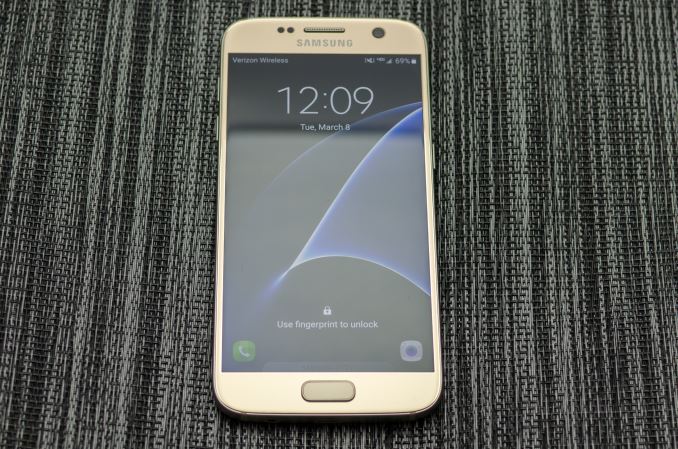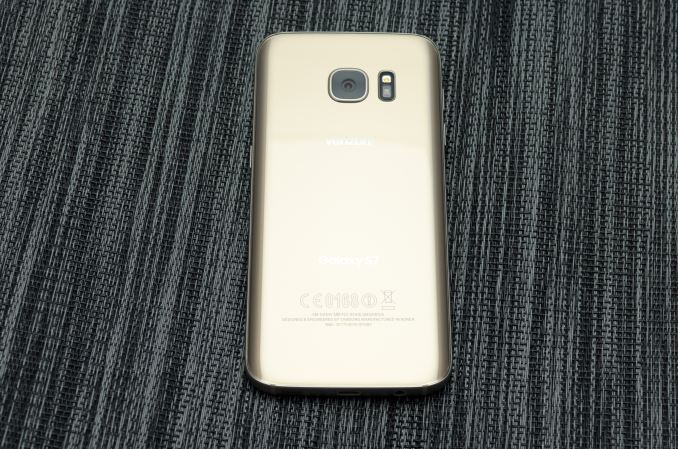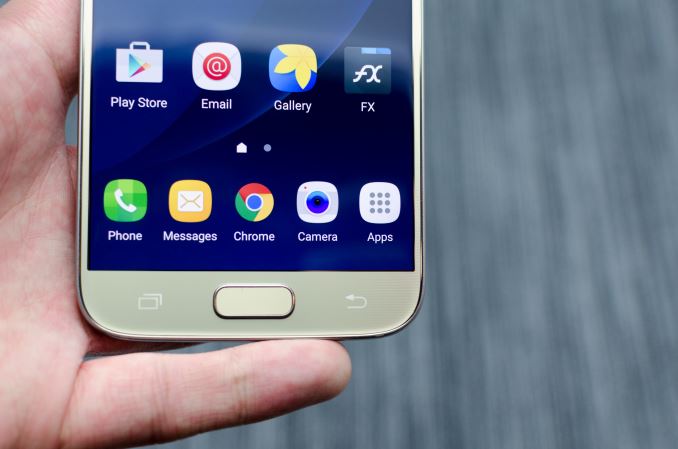The Samsung Galaxy S7 & S7 Edge Review, Part 1
by Joshua Ho on March 8, 2016 9:00 AM ESTInitial Conclusions
Even though we’re just barely scratching the surface of what we can test, the results we already have show quite a bit about the Samsung Galaxy S7. The Galaxy S line remains one of the most popular Android smartphones, and if history is any indication we can get a pretty good idea about what to expect for 2016 just by looking at the Galaxy S7 and S7 edge.
The first place we can start is design, and here we can see that the Galaxy S7 is decidedly an evolution of the Galaxy S6’s ID. However, pretty much every sharp edge has been rounded out to make the device more comfortable in the hand. The device has also been thickened in order to handle the larger battery and reduce the apparent z-height of the camera. The display size of the Galaxy S7 (non-edge) stays at 5.1 inches, and given how long Samsung has stuck to this display size it’s likely that they will be staying at this size for quite some time for their flagship.
In general, it feels like the industry has settled upon a display size somewhere between 5 to 5.5 inches for their flagship devices as going further probably won’t make a lot of sense for ergonomic reasons. I suspect Samsung and many other Android OEMs are settling into an Apple-like 2 year cadence for industrial and material design as replacement cycles lengthen, especially in the United States where subsidized phones have been almost entirely eliminated.
Meanwhile, though we haven’t had the time to run our full suite of battery life benchmarks, the data that we do have is quite interesting. At the very least, it looks like the Galaxy S7 will be a solid upgrade for those coming from the Galaxy S6 and earlier with a 15% bump in battery life or so. Anyone using a phone with an SoC not on a FinFET node will see even bigger gains to battery life, which is impressive to say the least. If you have any device with a Snapdragon 810 or 808 SoC, you’re definitely going to see major gains if you move to any device with a SoC fabricated on a FinFET node.
In terms of SoC performance, the Snapdragon 820 doesn't disappoint. In the time since testing the MDP it seems that between Qualcomm, Samsung, and Google, the trio has finally been able to optimize Snapdragon 820 for Chrome, so performance there is quite acceptable now and a pretty solid uplift over something like the Exynos 7420 or Snapdragon 810. GPU performance is also pretty much right where the Snapdragon 820 MDP was, so performance should be a good step above the A9's GT7600 GPU. Of course, we have yet to consider the power efficiency or sustainability of this performance, but turbo/overdrive performance is always relevant in the mobile space considering just how bursty almost every mobile workload is. It's pretty safe to say that Qualcomm has at least regained their footing in the SoC space, and with future SoCs they may well come to dominate the high end for performance and power once again. For now, it's looking like the race between Exynos 8890, Snapdragon 820, and Kirin 950 will be quite close.
For storage performance, to some extent it seems that the performance gains are relatively small, as the UFS 2.0 storage solutions on the Galaxy S6 and S7 are relatively similar. It’s interesting to see here that despite the now-mandatory use of FDE, the delta in performance between the Galaxy S6 and S7 in storage performance doesn’t seem to exist. This is welcome news as it wasn’t all that long ago that FDE for Android had a noticeable effect on storage performance.
On the display side, again we can see that the Galaxy S7 has a relatively similar display to the Galaxy S6. Calibration should be relatively good across the board, and AMOLED retains all of its traditional advantages including high contrast, support for wide color gamuts, low transition time, and improved power efficiency at lower average picture levels. Peak brightness is the only noticeable area where things seem to change, but I suspect that this will vary noticeably depending upon the unit. The one issue that I continue to notice here is that the edge display on the Galaxy S7 edge has a green tint at the edges, likely due to the diamond PenTile subpixel arrangement.
On the software side, Samsung’s TouchWiz UI continues to be more of the same when compared to the Galaxy Note5. The edge features continue to be somewhat interesting, but I continue to find myself thinking that there would be no difference if the same feature was implemented on the non-edge variant. Thankfully, the lag that I noticed last month in my initial hands-on time with the device seems to just have been a function of pre-release software, as the Galaxy S7 is relatively performant here. Although I’m not sure I’d go as far as to say that the Galaxy S7 is entirely free of lag. I suspect that Samsung has to balance power efficiency and responsiveness to some extent here, as while devices like the Nexus 5 can feel incredibly smooth and responsive there are very real knock-on effects in terms of practical battery life.
I’m also looking forward to testing features like Samsung Pay that are finally being deployed to the extent that I can use my personal credit card with Samsung Pay on my phone. However, out of the box TouchWiz still has some issues with an overly-neon theme, and in general things like Always-On Display already feel like they aren’t quite executed as well as they should be. I also noticed that the fingerprint scanner performance is strongly influenced by initial setup if I didn’t scan some areas on initial setup they never seemed to work very well unless I retrained the finger.
As for making a choice between the Galaxy S7 edge and Galaxy S7, there basically aren't any outside of size for the most part. There is the edge display, but by and large it feels like that's more of an aesthetic choice than a functional one. As we have seen you do get better battery life in the Galaxy S7 edge, but I don't feel like it makes sense to cross-shop the two. If you want one-handed usability, the Galaxy S7 is the only choice that makes sense. If you want a phablet, the Galaxy S7 edge is the only choice that makes sense.
Overall, I think the Galaxy S7 is looking to be one of the better devices of the year. Of course, there’s still a lot more to test, but the initial indications are already looking quite good. If you absolutely want the Galaxy S7 now, I don’t think there will be any major showstoppers present in this phone. However, if you’re looking to buy the best phone possible available this year I think it’s still too early to say where the chips will fall as Samsung's eager competitors have their own flagship phones right around the corner.














202 Comments
View All Comments
jjj - Tuesday, March 8, 2016 - link
Oh wow, you had 1 must do here, run GFXBench long time perf and you fail to do so, keeping everybody in the dark about the 1 thing we don't know.That 1 key result has 10 time more value today than this article...
Ryan Smith - Tuesday, March 8, 2016 - link
There was enough time to run one battery life benchmark or the other one. We picked the web benchmark, as that's the more useful of the two.hans_ober - Tuesday, March 8, 2016 - link
Add it for the full review.Hoping for a deepdive on S820/ Exynos/Kirin950/A9? like the E7420 deepdive you guys did.
Ryan Smith - Tuesday, March 8, 2016 - link
You'll see a GFXBench rundown in part 2.As for a deep-dive, we'll be doing some architectural information, though power logging ala the E7420 review will be a separate, larger writeup.
hans_ober - Tuesday, March 8, 2016 - link
You've made my day :)jjj - Tuesday, March 8, 2016 - link
If true that's a bad business decision especially when you did run 2 different battery tests.The fact that the article tries to dismiss the GPU throttling by claiming that mobile gaming is short sessions does seem to suggest a lack of understanding. Sure casual gamers that dgame just to waste time will go for short sessions and less demanding games but for them the perf is also of little to no relevance. Users that should care about the GPU perf are the ones that play longer sessions.It's also of dubious ethics to label the GPU perf in any way without knowing this key metric and not doing so is essential in differentiating AT from others.
Cygni - Tuesday, March 8, 2016 - link
Mad about telephone reviews.Kepe - Tuesday, March 8, 2016 - link
Why don't you just start your own tech-related website and write your own reviews, "jjj". You don't seem to do anything other than bitch and moan about every single conceivable thing you can come up with. Just gtfo and do things better by yourself, as you seem to know how everything should be done. If you write some good stuff, maybe you'll earn a buck or two, too.maximumGPU - Wednesday, March 9, 2016 - link
Second that. Never read anything except criticism from that guy on every post. Gets old very quickly.retrospooty - Thursday, March 10, 2016 - link
3rd it... I was on with him on a separate thread. Seriously hard headed, and overthinking it.